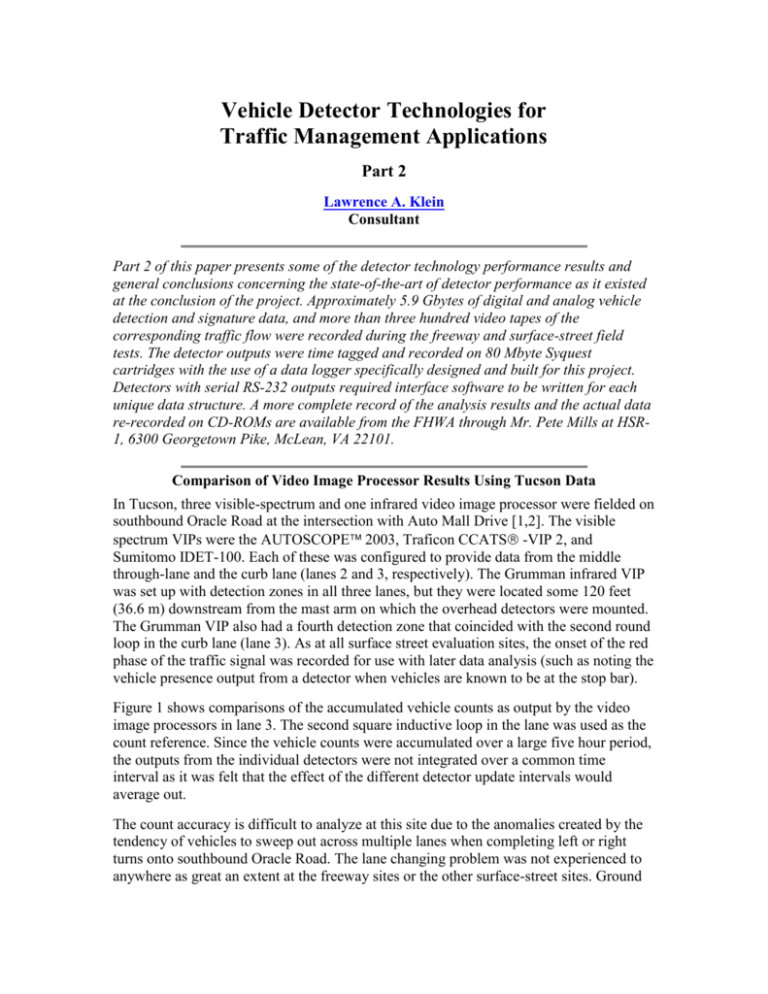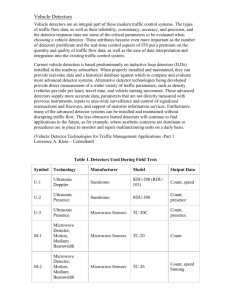Vehicle Detector Technologies for Traffic Management
advertisement

Vehicle Detector Technologies for Traffic Management Applications Part 2 Lawrence A. Klein Consultant Part 2 of this paper presents some of the detector technology performance results and general conclusions concerning the state-of-the-art of detector performance as it existed at the conclusion of the project. Approximately 5.9 Gbytes of digital and analog vehicle detection and signature data, and more than three hundred video tapes of the corresponding traffic flow were recorded during the freeway and surface-street field tests. The detector outputs were time tagged and recorded on 80 Mbyte Syquest cartridges with the use of a data logger specifically designed and built for this project. Detectors with serial RS-232 outputs required interface software to be written for each unique data structure. A more complete record of the analysis results and the actual data re-recorded on CD-ROMs are available from the FHWA through Mr. Pete Mills at HSR1, 6300 Georgetown Pike, McLean, VA 22101. Comparison of Video Image Processor Results Using Tucson Data In Tucson, three visible-spectrum and one infrared video image processor were fielded on southbound Oracle Road at the intersection with Auto Mall Drive [1,2]. The visible spectrum VIPs were the AUTOSCOPE 2003, Traficon CCATS -VIP 2, and Sumitomo IDET-100. Each of these was configured to provide data from the middle through-lane and the curb lane (lanes 2 and 3, respectively). The Grumman infrared VIP was set up with detection zones in all three lanes, but they were located some 120 feet (36.6 m) downstream from the mast arm on which the overhead detectors were mounted. The Grumman VIP also had a fourth detection zone that coincided with the second round loop in the curb lane (lane 3). As at all surface street evaluation sites, the onset of the red phase of the traffic signal was recorded for use with later data analysis (such as noting the vehicle presence output from a detector when vehicles are known to be at the stop bar). Figure 1 shows comparisons of the accumulated vehicle counts as output by the video image processors in lane 3. The second square inductive loop in the lane was used as the count reference. Since the vehicle counts were accumulated over a large five hour period, the outputs from the individual detectors were not integrated over a common time interval as it was felt that the effect of the different detector update intervals would average out. The count accuracy is difficult to analyze at this site due to the anomalies created by the tendency of vehicles to sweep out across multiple lanes when completing left or right turns onto southbound Oracle Road. The lane changing problem was not experienced to anywhere as great an extent at the freeway sites or the other surface-street sites. Ground truth was obtained for a 1-hour time window for lane 3 and compared to the counts reported by several detectors. The counts from the second inductive loop in the lane were approximately 2.5 percent higher than the observed ground truth. However, the decision to manually record a vehicle passage as a count was a judgment call on the part of the observer watching the video of the traffic flow. Vehicles completing their turns may have passed through enough of a detector's sensing area to trigger a response, but may not have been recorded by the observer. The observer was deliberately conservative in his determination of what constituted a detection and fully expected the detector outputs to be somewhat higher. Figure 1. Comparison of Vehicle Counts in Lane 3 from ILDs and VIPs in Run 04121633 at Tucson Surface Street Site Further data analysis indicates that the second loop in the lane represents the vehicle count to within an error of no more than 1 percent of the actual number of vehicles traversing its detection zone. The 1 percent number is judged to be a better representation of the error, as compared to the 2.5-percent value, since some vehicles detected by the loop were purposely not counted by the analyst. This judgment is supported by the fact that counts are high by the same percentage in each lane with respect to the analyst's ground truth values. Also lending credence to the lower 1 percent count error for the loops is the close agreement among the counts given by the loops in lane 3 as seen in Figure 1. The second square inductive loop reported a total count of 1600 vehicles collected over nearly 5 hours. The first round loop located 15 feet (4.6 m) downroad from the second square loop reported 1603 vehicles, and the second round loop located another 15 feet (4.6 m) downroad reported 1608. The locations of these three in-road detectors were well downstream and less susceptible to the vehicle maneuvering problems discussed previously. For these reasons, the counts shown in Figure 1 are compared with the high-accuracy outputs given by the second square inductive loop in the lane. When darkness occurs, vehicle counts recorded by the CCATS -VIP 2 fall off as compared to counts from the other detectors. This is due to the particular algorithm in software version E1.01 supplied with the CCATS -VIP 2 that was tested. The algorithm was not able to distinguish all the dark-colored vehicles from the dark background. This phenomenon was observed in the field when viewing the television monitor that showed the traffic flow and the overlaid vehicle counts displayed by the VIP. The algorithm was written to prevent shadows from being recognized as vehicles. Traficon has since developed software version 2 which they claim increases the count between 9 and 20 percent, depending on the conditions of the run. The Grumman imaging infrared traffic sensor records data from several detection zones. Zone 4 was the closest to the other detectors at the site and overlapped the second round loop in lane 3. As indicated in Figure 1, the counts from Zone 4 were 22 percent less than those from the second square loop. However, this particular model of the imaging infrared traffic sensor was not designed to count individual vehicles. It was designed to give a presence output every one second if one or more vehicles were within its detection zone in the preceding 1-second interval. Thus, if two or more vehicles passed through the detection zone in an interval, the sensor would register only one event. From observation of the traffic flow, it appeared that multiple vehicles did pass through the sensor's detection zone during some of the one second intervals. Future analysis can be used to verify the more than one vehicle per reporting interval hypothesis by overlaying the vehicle detections onto the video ground truth imagery and examining the correlation of reported and actual events. If the sensor consistently detects the first of two closely spaced vehicles but misses the second, this would indicate that the undercount is indeed due to the particular way the data are processed in the internal algorithms of the sensor. The crisp infrared imagery displayed on the television monitor appears to produce good thermal contrast between the vehicles and the background during day and night operation. This indicates that there is sufficient information in the image to recognize individual vehicles, and thus also to develop an accurate counting algorithm. Another type of analysis that can be performed with the recorded data is to compare the detector outputs on a signal cycle by signal cycle basis. This analysis is facilitated by the availability of the start and end times of the red phase signal that were also recorded in the data base. Furthermore, the detector outputs can be correlated with the video showing vehicle passage through the stop bar at the traffic signal. Comparison of Vehicle Counts and Lane Occupancies From Florida Freeway Data The Florida freeway site was a section of three-lane westbound I-4 in Altamonte Springs just north of Orlando. The overhead detectors are shown in Figure 2. In addition to these detectors, a side-mounted RTMS microwave radar was installed on the opposite side, eastbound shoulder of the freeway to monitor traffic flow in the westbound lanes [2]. Figure 2. Overhead Detector Installation on Westbound I-4 Freeway at Altamonte Springs, Florida Figure 3 gives the accumulated counts, referenced to ground truth values, for detectors representing five different technologies. The most accurate detector in lane 1 (the leftmost lane) in terms of count was the inductive loop, whose accuracy was computed to be 99.8 percent over this one-hour interval. The side-firing RTMS true-presence microwave radar was second in terms of percent error, but this accuracy is overstated as explained below. Examination of the curves in Figure 3 shows the RTMS counts lagging those of the other four detectors until about midway through the hour. The video of the run indicated that during the first half hour, traffic flow slowed and eventually resulted in bumper to bumper conditions for the remainder of the hour. During the second half of the hour, when the vehicle flow decreased further, the count rate decreased for all detectors except for the side-firing RTMS. Thus, the continued accumulation of vehicles by the RTMS during the second part of the hour compensated for its lower count during the first half of the hour. The reason for this appears to be that the RTMS is counting some vehicles more than once during periods of heavy congestion. It is likely that multiple reflections of the radar signal from the vehicles contributed to the overcount in the second half of the hour. Figure 3. Comparison of Vehicle Counts with Ground Truth for Five Detectors in Lane 1 from the I-4 Florida Freeway Site Figure 4 contains plots of lane occupancy (the percent of time the detection zone of a detector is occupied by some vehicle) for three lane 1 detectors operating in the presence mode during Run 07150617. They were the side-looking RTMS microwave radar, the SDU-300 ultrasonic detector, and the AUTOSCOPE 2003 VIP. Predictably, the presence-type devices generated high occupancy values when the traffic slowed considerably, because at slower speeds, vehicles dwell for a longer time period in the detector’s sensing area. The difference in the occupancy values among the presence detectors is due to the difference in hold or integration times of each detector and the size of their sensing area. Thus, if occupancies are to be used for traffic control and management, a single type of detector should be deployed along the entire stretch of roadway that is being monitored. Figure 4. Comparison of Lane Occupancies from Ultrasonic, Microwave Radar, and VIP Detectors in Lane 1 Using Data from the I-4 Florida Freeway Site During periods of high occupancy, two closely-spaced vehicles occupy a portion of the same detection zone before the falling edge of the pulse generated by the lead vehicle has been processed. This causes the passage of these two (or more) vehicles to be often interpreted as a single event and the detectors to undercount during periods of bumper-tobumper traffic. Conclusions We attempted to obtain data showing the percent error in vehicle count, as output by a given detector, in each of 30 selected runs where detector counts were compared to ground-truth values. In some instances no data were obtained due to no fault of the detector (e.g., the device was not fielded during that run or the setup was known to be sub-optimal in some way). In other cases, no results were obtained due to detector failure or instances in which extremely poor results were attributed to detector malfunction. In order to account for the different number of detected vehicles in a run, cumulative count errors were computed as shown in Table 1. In this process, the count error was found by first forming the difference between the sum of the vehicle counts made by a given detector over all 30 runs and the ground truth vehicle count for the same runs. Then this result was divided by the total number of vehicles as given by the ground truth count. For example, if 9,600 detections were made by a detector over the 30 runs as compared to a ground truth count of 10,000 for the same runs, the percent error would be 4 percent. Table 1. Cumulative Count Errors Detector Cumulative Error Detector Cumulative Error TDN30 (1) TDN30 (2) AUTOSCOPE (1) AUTOSCOPE (2) ILD(1) ILD(2) TC30C SDU300(1) SDU300(2) -4.3 -3.8 -4.7 -1.6 +0.1 +0.1 -5.4 -5.0 -3.5 SPVD Mag RTMS (fwd) RTMS (side) 833 842 TSS1 TC26 780D1000 (Autosense I) -6.6 -1.1 -3.3 4.2 12.2 +11.3 15.4 -3.3 The most consistently accurate detector in terms of count was the inductive loop. The non-weighted means of the two ILDs reflected overcounts of 0.8 and 0.4 percent, respectively, while the standard deviations of 2.6 and 3.1 percent were among the tighter groupings observed. Even then the numbers were inflated by the Phoenix freeway results, where improper loop installation led to crosstalk problems, and the Minnesota surface street tests where frequent lane changes coupled with light traffic conditions could lead to overly-exaggerated count errors. Recomputing the errors without the influence of the Minneapolis street and Phoenix freeway data yields a mean error of -0.20 percent and a standard deviation of 0.83 percent for ILD1 (the first loop encountered by vehicles in a given lane), and a mean error of 0.01 percent with a 1 percent standard deviation for ILD2 (the second loop encountered by vehicles in a given lane). These results indicate that the inductive loops meet even the most stringent of the vehicle flow error specifications for the several Intelligent Transportation System applications analyzed during the program. Following the loops in count accuracy, with results in the 1 to 2 percent error category, were the forward-looking RTMS and one of the AUTOSCOPE 2003 outputs. The next most accurate detectors in terms of count, were those with errors in the 3 percent to 7 percent range. These included the TDN-30, the second AUTOSCOPE 2003 lane output, TC-30C, SDU-300, SPVD magnetometer, side-looking RTMS, and the 833. The detectors exhibiting worst count accuracy were the 842, SmartSonic, and TC-26. The poorer performance of this group was due in part to built-in large hold times and designs that were not optimized for the service they experienced during the field evaluations. Several of them have undergone extensive redesign since the conclusion of these field tests and may now be better optimized for the services that were evaluated. Those that have been redesigned or modified include the RTMS, Autosense I, 842, 833, AUTOSCOPE , CCATS, SmartSonic, and the SPVD. Table 2 contains a qualitative assessment of the best performing detector technologies for acquiring specific traffic flow parameters. Caution must be exercised when applying the information in this table. For example, the microwave Doppler detector appears to provide all of the parameters listed. However, it is not designed to detect stopped vehicles. Therefore, the Doppler detector is not suited for an application that requires this specific function (such as at a stop bar, traffic signal, or in some cases, detection of vehicles on a freeway). Table 2. Qualitative Assessment of Best Performing Technologies for Acquiring Specific Traffic Flow Data Technology Vehicle Count in Low Volume Traffic Vehicle Count in High Volume Traffic Vehicle Speed in Low Volume Traffic 4 Vehicle Speed in High Volume Traffic 4 Best in Inclement Weather Microwave Doppler* 4 4 4 Microwave True Presence 4 4 Passive Infrared --- --- --- --- --- Active --- --- --- --- --- Ultrasonic --- --- --- --- --- Passive Acoustic Array --- --- Visible Spectrum VIP 4 4 SPVD Magnetometer 4 --- 4 Infrared --- --- --- 4 Inductive 4 4 --- --- 4 Loop 4 indicates best performing technologies. --- Indicates performance not among the best, but may still be adequate for the application. No entry indicates not enough data reduced to make a judgment. * This technology does not detect stopped vehicles. Issues that must still be resolved by detector manufacturers include: Standardization of serial data transfer protocols Assistance in setting realistic expectations by traffic operations personnel by not overselling the capabilities of their devices and by more accurately predicting their performance in specific applications. On the other hand, transportation agencies must let the manufacturers know what their future needs are so that these requirements can be incorporated into the next generation detector designs and their cost impact be made known to the agencies. References [1] L.A. Klein, M.R. Kelley, and M.K. Mills, "Evaluation of Traffic Detection Technologies for IVHS," SPIE Vol. 2344 Intelligent Vehicle Highway Systems, 1994, pp. 42-53. [2] L.A. Klein, M.R. Kelley, and M.K. Mills, "Traffic Detection Technologies for a Modern Transportation Infrastructure," SPIE Vol. 2592 Collision Avoidance and Automated Traffic Management Sensors, 1995, pp. 99-113. [3] L.A. Klein and M.K. Mills, "Evaluation of Modern Traffic Detector Technologies for IVHS Applications," Proc. National Transportation Data Acquisition Conference NATDAC ‘94, Sept. 18-22, 1994, Report FHWA-CT-RD 2304-F1-94-1, Vol. II, National Technical Information Service, Springfield, VA 22161, pp. 515-533. ABOUT THE AUTHOR Lawrence A. Klein is a consultant developing multiple sensor system, communications, and system architecture concepts for intelligent transportation systems and defense applications. He holds a Ph.D. in electrical engineering from New York University. While at Hughes Aircraft Company, Dr. Klein was the Principal Investigator on the Detection Technology for IVHS program and led several ITS architecture development projects. In addition to extensive publications in the ITS arena, he has authored the books Sensor and Data Fusion Concepts and Applications for the SPIE and Millimeter-Wave and Infrared Multisensor Design and Signal Processing for Artech House. Dr. Klein can be reached at: Phone: (714) 996-9066. E-mail: laklein@wdc.net. To return to ITS Online's Cover Page, press the "back" button on your web browser or click on our logo below. © 1997 by Communication Alchemy, Inc., Austin, TX. Phone: (512)219-1966 FAX:(512)219





